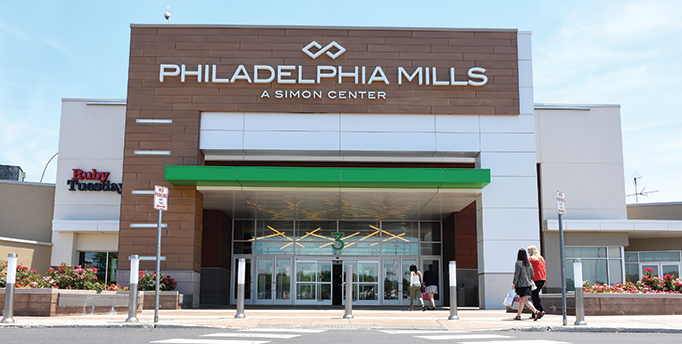
When Franklin Mills opened in Philadelphia on May 11, 1989, The Philadelphia Inquirer heralded “The Mall to End Them All.” In fact, it was the world’s largest outlet mall and also a shopping destination that would become one of this historic city’s largest tourist attractions. The $300 million mall, named after Philadelphia native son Benjamin Franklin, was the second-largest shopping center in Pennsylvania and only the second of what would become a portfolio of 18 large factory outlet projects The Mills Corp. would build over the next two decades. The nearly 1.8 million-square-foot project featured what would become Mills trademarks: four color-coded entrances, a collection of retailers not replicated anywhere in the vicinity and signage that was considered avant-garde. Even the central design aesthetic invoked Mr. Franklin, since the shopping center was designed in the shape of a lightning bolt. This was also the first Mills property to feature not one but two food courts.
Today, nearly 30 years on, much has changed across the American retail landscape, of course. In 1989 outlet retail was considered novel; today it is a staple. There are some 200 outlet centers in the U.S., totaling nearly 80 million square feet and at an average age of 17 years, according to ICSC. Roughly 40 more outlet centers are projected to open between now and 2018 across 20 states, which will add 15 million square feet to the existing inventory.
Against this context Simon, which owns the Mills division, engaged Rochester, N.Y.–based Bergmann Associates to undertake a $30 million renovation of Franklin Mills starting back in the fall of 2014. The renovation began with the formal name change to Philadelphia Mills. “We wanted to pick something that was indigenous to the Philadelphia market, since we have such a wide draw and trade area,” said Michael Romstad, senior vice president of property management at Mills. The time was right for a major change, he says. “We needed to revitalize the center and freshen the envelope and really elevate the experiences that we provided to our customers from top to bottom. Our investment in the reinvention of Philadelphia Mills was our way to really reinforce our position in the market as the city’s premier family-friendly shopping-and-dining destination.”
As the work nears completion, significant updates have already been made to exterior and interior alike. These include new mall entrances, parking lots and landscaping, brighter LED lighting, new skylights and flooring, a dining pavilion and upgraded restrooms. Such customer amenity enhancements as soft-seating lounge areas equipped with device-charging stations have been introduced too. “From top to bottom, customers are going to see a great new experience at Philadelphia Mills,” said Romstad.
The renovation has drawn new retailers, among them Express Factory Outlet, Rack Room Shoes, Samsonite and Steve Madden. Some existing retailers, including H&M, Marshalls and Saks Off 5th, have reinvested in their sites with renovations of their own.
But while the typical Mills centers — and outlet malls in general, for that matter — are located in far-flung suburban areas, Franklin Mills was built on an urban site that was denser than usual, only 15 miles from central Philadelphia. “The perception was that these projects typically had to be on the fringe of a major city or in a remote location, and Philadelphia Mills was and continues to be in the heart of a very dense part of Philadelphia, in the northeast section,” said Steve Gartner, CBRE’s executive vice president of retail services in Philadelphia. “That, in and of itself, made it pretty pioneering.” According to Gartner, it became one of the biggest tourist attractions in Pennsylvania, benefiting from its location between New York City and Washington, D.C., and along I-95. That advantage had eroded in recent years, however. “What it faces in 2016 is a huge proliferation of outlet projects, off-price projects and retailers that are locating their outlets or discount channels in conventional malls, in street retail,” said Gartner.
Simon does not report sales statistics for the Mills division, but value-branded offshoots of traditional department stores, such as Nordstrom Rack and Macy’s Backstage, have become huge competitors to outlet centers. “I don’t know how far $30 million gets you nowadays,” said Gartner. “Retail projects are the sum of their parts, so it all comes down to the stores. If the money is spent to create ambiance, that just keeps you even. Ultimately, it’s the collection of stores that makes the project.”
Romstad notes that Philadelphia Mills remains relevant, despite the competition. “There are 16-plus anchor department stores in this one complex, with 200 stores and a mix of value-oriented retail and entertainment,” he said. This has made it one of the premier destinations in its market for the past 25 years, he says. “It’s a concept that’s tried, true [and] tested, and it performs in a variety of economic cycles, so we’re very bullish on this center and the concept itself. Philadelphia Mills is a very solid, strong asset, and that’s why we are redeveloping it — because we have faith in its ability to continue to grow market share.”

